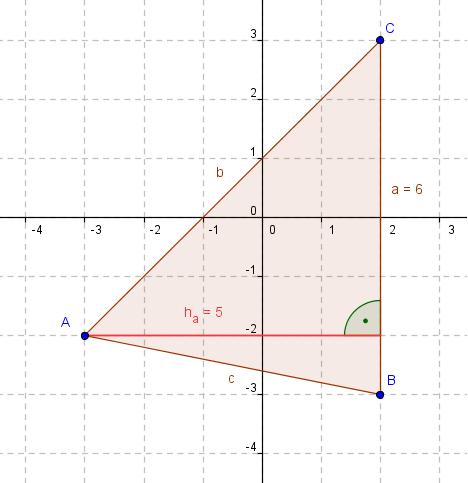Dreieck: Unterschied zwischen den Versionen
Aus RMG-Wiki
| Zeile 48: | Zeile 48: | ||
{{Lösung versteckt| | {{Lösung versteckt| | ||
| − | + | A<math>=</math>6 cm <math>\cdot</math> 3 cm : 2<math>=</math>9 cm² | |
| − | < | + | a<sub>neu</sub><math>=</math>10 cm |
| − | + | h<sub>a,neu</sub><math>=</math> A : a <math>=</math> 900mm² : 100 mm <math>=</math> 9mm <math>=</math> 0,9 cm | |
| − | |||
| − | |||
| − | |||
| − | |||
}} | }} | ||
Version vom 22. September 2010, 14:43 Uhr
1.Aufgabe
Arbeitsauftrag:
- Zeichne die Punkte A(-3|-2), B(2|-3) unc C(2|3).
- Verbinde sie zu einem Dreieck.
- Berechne die Fläche.
2. Aufgabe
Seite 118, Aufgabe 11
1. Drachenvierreck:
Die Diagonale f teilt das Dreieck in zwei gleichgroße Teildreiecke. Die Hälfte der Diagonalen e ist die Höhe der Dreiecke.
Die Fläche eines Teildreiecks errechnet sich aus:
A
 f
f e : 2
e : 2  : 2
: 2
A 7 dm
7 dm  4 dm : 2 : 2
4 dm : 2 : 2
A 7 dm²
7 dm²
Das Drachenvierreck besteht aus zwei Teildreiecken.
Ages 7 dm² + 7 dm²
7 dm² + 7 dm²  14 dm²
14 dm²
2.Drachenvierreck
A 80 dm
80 dm 39 dm : 2
39 dm : 2 2
2
A 3120 dm²
3120 dm²
3. Aufgabe
Seite 119, Aufgabe 15 a)
A 6 cm
6 cm  3 cm : 2
3 cm : 2 9 cm²
9 cm²
aneu 10 cm
10 cm
ha,neu A : a
A : a  900mm² : 100 mm
900mm² : 100 mm  9mm
9mm  0,9 cm
0,9 cm


